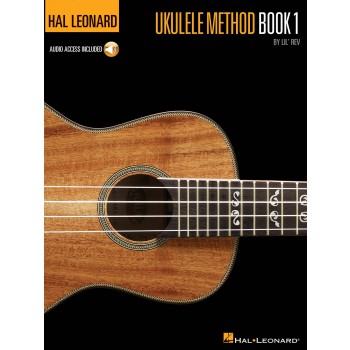
It's laid out with all of the requisite parts of the ukulele, history, etc. and introduces individual pitches first. (Excellent!) However, he also introduces Tablature (TAB) right away. (Sigh) Truly, I think there's a place for Tablature in our teaching; it's a great way for a student to make a note to themselves about fingering, or to show where a new note is. If it was shown on the first example of each set of exercises to help students find the notes, then they had to play the rest of the exercises without it, I would have been happier. Instead, the first exercise of the whole book does not have it, and then every exercise after that does have it.
One of the things I really like about his approach is that as he introduces each string, starting with string 3 (middle C), he gives at least 4 simple exercises reading the 2-3 notes on each string in the first position. Each exercise is only 4 measures long, giving students a chance to be successful in short bursts. The other thing I appreciate about the examples is that each one introduces some sort of change in pattern so that students need to actually look at the music to play it, or get caught off-guard playing a wrong.
A minor quibble here: the book includes the note names above every note for each page that introduces new notes. I have found that when it comes to the tunes that they have to play to apply those notes (Frere Jacque is the first), they have only been looking at the note names rather than making the connection of the location of the notes on the staff. When the letter names are not written in, they are unable to recognize them any more, and often feel the need to write in letter names after that. I would have preferred that the book would do it for the first exercise, then for just the first measure of the next exercise, then maybe just the first note of the following. Ween the students off of them!
When it introduces chords, things do get a bit strange, however. First of all, when chord diagrams are shown with fingering, there are some strange fingerings suggested. (I find it odd to suggest to use the second finger to play the C Major Chord.) The major issue, however, is that after I think the book does a laudable job of gradually teaching notes & rhythms, it starts with a basic quarter-note down strum for chord changes. Good. It continues with the same strum on the next page, using the finger instead of thumb. (I'm not big on using the thumb for a down-strum, but okay...) Suddenly, the next page, it introduces a strumming pattern that is a multi-finger strum incorporating quarter, eighth and sixteenth notes in a combination of down & up strums. At this point, we haven't even discussed a basic eighth-note down-up strum! Worse, it's not notated in standard notation, making it even more difficult to figure out exactly the rhythm we should be hearing. It comes out of nowhere, and is a very strange place to introduce it.
When teaching my 9-week course, at the point we reach chords, I teach from the board and handouts instead, since I find this part of the book completely unusable for classroom use.
Overall, you can make this work, but it's certainly not great for classroom teaching. On the other hand, it's one of the better ones out there, which is a rant for another time.
Positive:
Gradual teaching of individual pitches first
Several 3-4 bar exercises per introduced pitch
Familiar tunes to apply newly learned notes
Weaknesses:
Some odd chord fingerings
Strumming pattern difficulty ramps suddenly
Tiny Tim Syndrome (T.T.S) - A tendency not to take the instrument seriously at the same time as teaching it
 RSS Feed
RSS Feed
